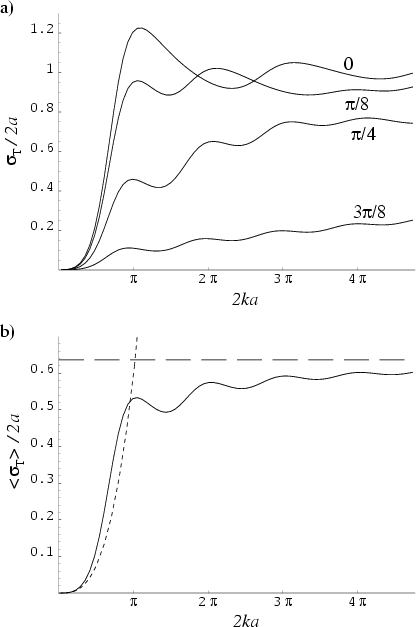In traditional scattering
theory, partial waves
form a basis in which to decompose the asymptotic
(
![]() ) form
of the full wavefunction
) form
of the full wavefunction ![]() into
incoming and outgoing states of definite angular momentum
into
incoming and outgoing states of definite angular momentum ![]() .
The basis functions are the cylindrical (in 2D) solutions to the free-space
wave equation;
the
.
The basis functions are the cylindrical (in 2D) solutions to the free-space
wave equation;
the ![]() -matrix which takes incoming to outgoing waves
can then be written in this basis [128].
Because there is only a single set of incoming channels
and a single set of outgoing channels, this is equivalent to a
scattering system (a stub) connected
to a single `lead', with an infinite number of open channel modes.
This contrasts the
open two-terminal geometry we study,
where we need to account for two new facts:
1) in the
-matrix which takes incoming to outgoing waves
can then be written in this basis [128].
Because there is only a single set of incoming channels
and a single set of outgoing channels, this is equivalent to a
scattering system (a stub) connected
to a single `lead', with an infinite number of open channel modes.
This contrasts the
open two-terminal geometry we study,
where we need to account for two new facts:
1) in the
![]() limit the potential
limit the potential ![]() no longer becomes
angular-momentum-preserving, and
2) there are now distinct ways the particle can enter and exit the system,
via different leads.
no longer becomes
angular-momentum-preserving, and
2) there are now distinct ways the particle can enter and exit the system,
via different leads.
We define a `half-plane partial-wave basis' as the subset of the cylindrical
free-space
solutions which go to zero on the entire ![]() -axis.
This gives independent basis functions existing on either the left or right
side
of the
-axis.
This gives independent basis functions existing on either the left or right
side
of the ![]() -axis. The basis is expressed in terms of
Hankel functions[7] on either side:
-axis. The basis is expressed in terms of
Hankel functions[7] on either side:
The corresponding outgoing (incoming) amplitude coefficients
are ![]() (
(![]() ) on the left and
) on the left and ![]() (
(![]() ) on the right.
Applying (7.5) to the aymptotic forms of the Hankel functions
) on the right.
Applying (7.5) to the aymptotic forms of the Hankel functions
![]() shows that a unit amplitude
carries a flux of
shows that a unit amplitude
carries a flux of ![]() , independent of channel index
, independent of channel index ![]() .
This results from the fact that all channels have the same
asymptotic particle velocity, equal to that in free space.
This contrasts the usual constant-width lead case where
the non-zero transverse energy results in an
.
This results from the fact that all channels have the same
asymptotic particle velocity, equal to that in free space.
This contrasts the usual constant-width lead case where
the non-zero transverse energy results in an ![]() -dependent asymptotic
velocity, and thus care is needed to include
a velocity factor in the normalisation
[74,187,55].
-dependent asymptotic
velocity, and thus care is needed to include
a velocity factor in the normalisation
[74,187,55].
Now we give a brief reminder of the recipe for the conductance
of a general completely-open single channel [20,65,55].
The channel is a 1D Fermi gas corresponding to the
longitudinal degree of freedom.
This can correspond to a conventional (constant-width) transverse
mode, to a Hankel (cylindrical) mode defined above, or indeed
to any situation where the Hamiltonian is separable into
(orthogonal) transverse modes and longitudinal motion in the asymptotic regime
7.6.
For a 1D Fermi gas the rightward-moving density of states
per unit length (including spin) is
![]() ,
where
,
where ![]() is the (group) velocity in the channel.
The current carried
is
is the (group) velocity in the channel.
The current carried
is
![]() in the relevant energy range
in the relevant energy range
![]() ,
giving a single `quantum' of conductance
,
giving a single `quantum' of conductance
![]() .
The important point is that the velocity factors cancel,
giving the
equipartition rule that
an equal current is carried by all open channels regardless of
their channel velocities.
.
The important point is that the velocity factors cancel,
giving the
equipartition rule that
an equal current is carried by all open channels regardless of
their channel velocities.
If the basis is chosen such that unit amplitude
coefficients carry equal fluxes
in all incoming and outgoing
channels, then flux conservation implies
the unitarity of the ![]() -matrix when written in this basis.
Then the results of the previous paragraph
generalise to the familiar Landauer formula
-matrix when written in this basis.
Then the results of the previous paragraph
generalise to the familiar Landauer formula
 |